Super Smash Bros. for Wii U/Nintendo 3DS
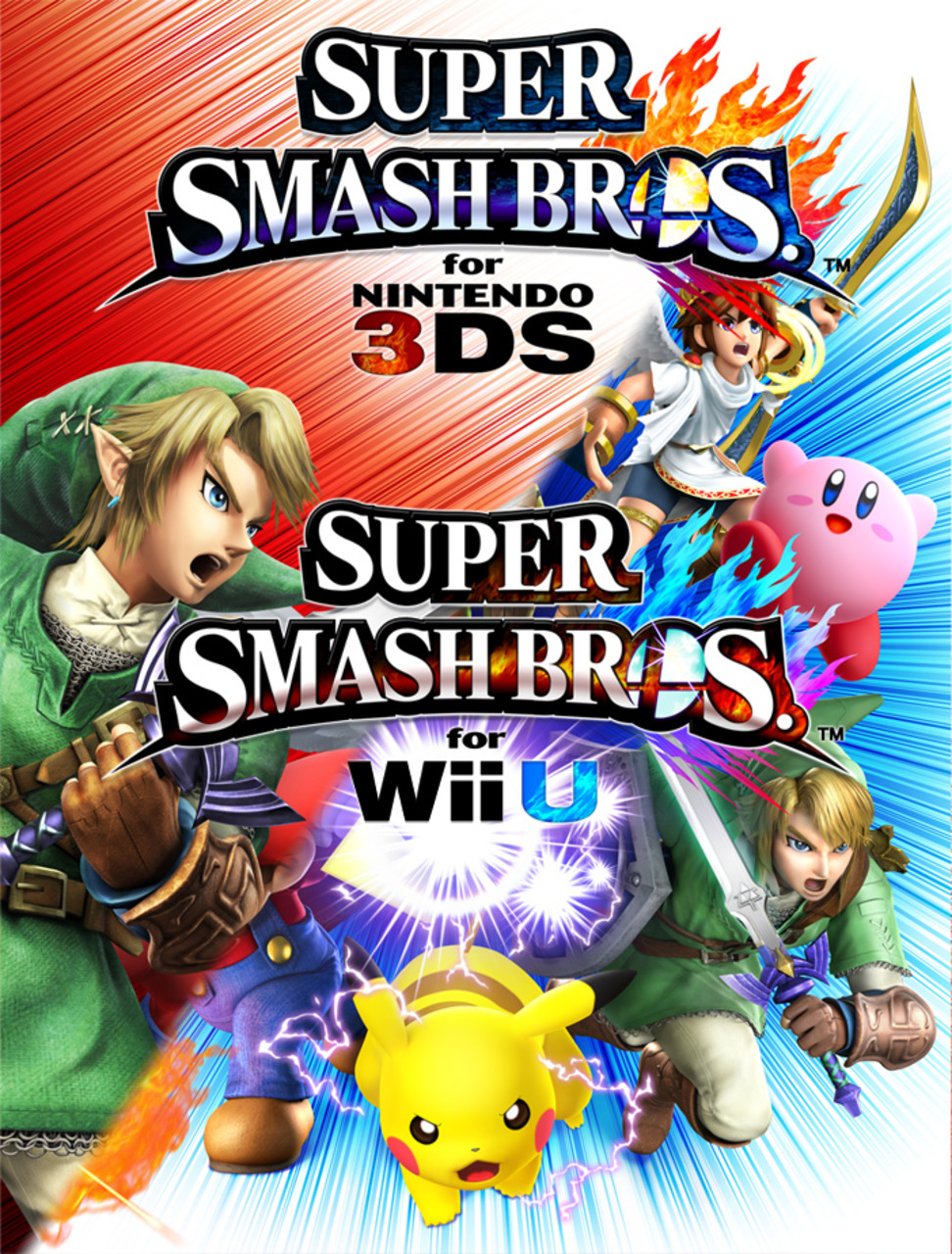
Overview
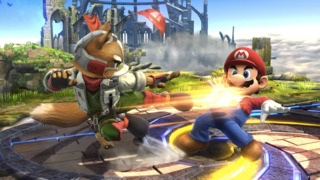
Super Smash Bros. for Nintendo 3DS & Wii U (known in Japan as Dairantou Smash Brothers for Nintendo 3DS & Wii U, translated to “Great Melee Smash Brothers for Nintendo 3DS & Wii U”) is a 2.5D crossover platformer-fighting game developed by Bandai Namco and Sora and published by Nintendo for two separate consoles:
- The first release, “Super Smash Bros. for Nintendo 3DS“, was released for the Nintendo 3DS in Japan on September 13, 2014, with both North American and European versions released on October 3, 2014. It is the first handheld entry in the series.
- The second release, “Super Smash Bros. for Wii U“, was released for the Wii U in North America (on November 21, 2014), in Europe (on November 28, 2014), and in Japan (on December 6, 2014).
The fourth installments of the Super Smash Bros. series (and the sequels to Super Smash Bros. Brawl), both versions of the game feature the same roster and gameplay mechanics but have different stages and special game modes. It is often known collectively as “Super Smash Bros. 4”.
In addition to a new roster update (including support for custom Miis), the game introduces customizable characters (where players can collect equipment pieces to alter the stats and movesets of each character), amiibo support (where players can train special computer opponents tied to each figurine), and post-release downloadable content. There is no single-player story-based campaign in this installment.
The Wii U version supports eight-player multiplayer and high-definition graphics. The Nintendo 3DS version, on the other hand, supports stereoscopic 3D (with optional cel-shading), and StreetPass support (with a top-down minigame called “StreetSmash”) although it is missing some features from the previous game (including Stage Builder and Special Smash). The Wii U version has two exclusive modes: the “board game” inspired Smash Tour mode and the Special Orders challenge mode. The Nintendo 3DS version has one exclusive mode: Smash Run (based on City Trial mode from Kirby Air Ride).
While both versions of the game are not cross-play compatible, players with the Nintendo 3DS version of the game can use their Nintendo 3DS as a game controller (the only game to do so) for the Wii U version. In addition, players can transfer and use custom characters through this functionality. On June 14, 2015, Nintendo released a free “Smash Controller” app for the Nintendo 3DS that allows the game controller functionality without requiring players to use the Nintendo 3DS version of the game itself.
Gameplay
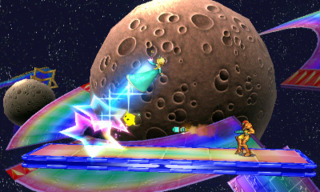
Super Smash Bros. retains the core fighting mechanics that are the series’ trademarks, pitting up to four fighters against each other in 2D arena spaces populated with a variety of platforms. The objective is to knock the opponents out of the arena and win by either scoring the most K.O.s, or in stock matches, until they are the only fighter left standing.
Returning from the previous entry, Super Smash Bros. Brawl, are a pair of mechanics introduced in that entry; Final Smashes and Assist Trophies. The Final Smash is a character-specific super move with effects that vary wildly from character to character. Assist Trophies are items that can be used to spawn the appearance of an NPC character or characters that can deal damage or impart some effect.
Online Play
Online play appears in both the Wii U and 3DS versions of Super Smash Bros. The online features and functionality have been expanded upon over Super Smash Bros. Brawl to include a greater variety of gameplay options. The most significant of these changes in terms of gameplay come in the form of new game modes for playing against strangers; For Fun, and For Glory.
In For Fun, the stage is randomly selected, and all stages except for Final Destination are possible battle locations. All items are also made available, but the mode is limited to Smash Battles only and there is no stat tracking of wins and losses. In For Glory battles, players are restricted to playing on Final Destination, but the stage now comes in a variety of skins that allow it to resemble flat versions of most of the games’ other battlefields. For Glory matches also restrict the appearance of items, and it is possible to be placed into one-on-one bouts. For Glory mode also keeps a tally of the player’s win record.
Global Smash Power
Rather than use traditional online leaderboards, global online rankings will use a stat called Global Smash Power. GSP is measured via parameters across the game, and rather than assign a rank such as being number one in the world, it instead calculates the player’s position relative to other players with lower GSP ratings. For example, a user with a GSP of 300,000 has a higher rating than 299,999 other players (not counting ties).
Game Modes
Wii U Version
Smash Tour
A board game-like mode for local multiplayer.
Special Order
Master Hand challenges.
3DS Version
Smash Run
Smash Run is a gameplay mode exclusive to the 3DS version. In this mode, up to four players have five minutes to run through a maze-like dungeon and defeat enemies while collecting stat-boosting power-ups that affect a variety of parameters. Once time is up, the players then face off against each other with their powered up characters. This mode supports local multiplayer only but can also be played solo against CPU opponents.
Custom characters used in Smash Run can be outfitted with additional powers that can be triggered via the touch screen. Such powers include triggering auto-healing or invincibility, the use of items such as hammers, or powering up specific attack types such as kicks.
StreetSmash
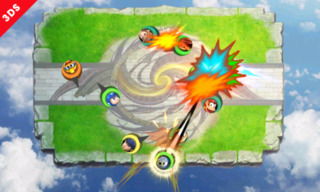
This mode is part of the 3DS version’s StreetPass functionality. Players met via StreetPass can be taken on in a top-down arena battle which has the player trapped in a rectangular platform with no bounds. To win, the player must charge at the opponent characters and push them off the stage and avoid being pushed off themselves. Winning in Street Smash yields various random rewards from Trophies to coins and other things.
Home Run Contest
A mini-game seen in previous Smash Bros. games, the 3DS version once again features the Home Run Contest. In this mode, the player must try to send a sand bag flying as far as possible after dealing damage to soften it up.
Target Blast
A new mini-game that functions like a cross between the Home Run Contest and games like Angry Birds. The player damages the bomb, which triggers a countdown. After enough damage is dealt and the bomb is sent flying, it will explode when the countdown concludes. The objective is to launch the bomb in such a way that the blast destroys blocks and walls to produce a cascade that will destroy as many targets as possible.
All-Star Battle
An endurance mode in which the player faces off against other characters with a limited supply of health restoration items. Each stage features multiple opponents to fight. When in the rest area, the game indicates which opponents are coming next, and also indicates the year in which these characters first appeared in a video game. More opponents become available to fight in this mode as more characters are unlocked.
Conquest Mode
Added via day-one patch (1.0.1) to the Japanese release, Conquest Mode is an online mode that, when selected, randomly triggers during online matches. Players can battle for special Conquest Battle Points and the winning characters will receive special in-game prizes. After each Conquest Mode activation, there is a cooldown period before the mode activates again.
Characters
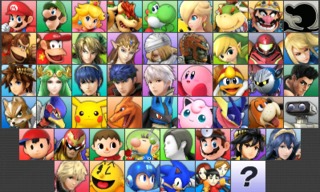
Both versions of the game sports the same roster of 49 playable characters (51 if each type of Mii Fighter is counted separately). 7 characters were later added as downloadable content.
Most characters from Super Smash Bros. Brawl have returned (the only exceptions being Ice Climbers, Snake, Wolf, and the Squirtle and Ivysaur parts of Pokémon Trainer), including three of the missing characters from Super Smash Bros. Melee (Dr. Mario, Mewtwo, and Roy). Two characters (Zelda and Samus) have had their unique transformations turned into separate characters. Sonic returns as a guest character from a third-party franchise, and two new guest characters are added (five after DLC).
Similar to Super Smash Bros. Melee, each of the hidden characters can be unlocked through either a special criteria (such as completing Classic Mode under a certain condition) or by completing certain amounts of matches in Vs. Mode. Some characters that are locked in the Nintendo 3DS version are unlocked in the Wii U version from the start. All unlockable characters must also be defeated in a special one-on-one one-stock match in order to be unlocked.
New Additions
- Villager (Animal Crossing) – Known as Murabito in the Japanese version. The outfits, gender, face style, and hairstyle can be changed using alternate costumes.
- Mega Man (guest character, Mega Man) – Known as Rockman in the Japanese version.
- Wii Fit Trainer (Wii Fit) – Alternatively, players can play as the male Wii Fit Trainer using alternate costumes.
- Rosalina & Luma (Mario) – Known as Rosetta & Chiko in the Japanese version. Similar to Ice Climbers, players control one character (Rosalina) with a second character (Luma) tagging along for attacks.
- Little Mac (Punch-Out) – Alternate costumes include his training wear and a wireframe design (based on the original Punch Out!!)
- Robin (Fire Emblem) – Known as Reflet in the Japanese version. Based on his default appearance. Alternatively, players can play as the default female Robin using alternate costumes.
- Mii Fighter (Mii Maker) – Special fighters that requires use of the character customization tool prior to playing. Has three special variants (Brawler, Swordfighter, and Gunner). They cannot be used when playing the “With Anyone” online mode and cannot be used in Smash Tour mode. In single-player modes, they only appear in Multi-Man Smash (as the “Fighting Mii Team”).
- Lucina (Fire Emblem) – Plays similarly to Marth. In the 3DS version, she is unlocked either after 40 Vs. Mode battles or by completing Classic Mode using Marth without continuing. In the Wii U version, she is unlocked either after 30 Vs. Mode battles or by completing Classic Mode on intensity 5.5 or higher.
- Dark Pit (Kid Icarus) – Known as Black Pit in the Japanese version. Plays similarly to Pit. In the 3DS version, he is unlocked either after 50 Vs. Mode battles or by completing Classic Mode with three separate characters. In the Wii U version, he is unlocked either after 40 Vs. Mode battles or by completing All-Star Mode on either Normal or higher.
- Bowser Jr. (Mario) – Known as Koopa Jr. in the Japanese version. Rides on his Junior Clown Car. Alternatively, players can play as one of the Koopalings (Larry, Roy, Wendy, Iggy, Morton, Lemmy, or Ludwig) using alternate costumes. In the 3DS version, he is unlocked either after 100 Vs. Mode battles or by completing Classic Mode using Bowser on intensity 6.0 or higher.
- Duck Hunt (Duck Hunt) – In the 3DS version, they are unlocked either after 110 Vs. Mode battles or by completing Classic Mode with eight separate characters. In the Wii U version, they are unlocked either after 100 Vs. Mode battles or by getting at least one KO in Cruel Smash Mode.
- Ryu (guest character, Street Fighter) – Added on June 14, 2015 as DLC.
- Cloud (guest character, Final Fantasy) – Based on his appearance in Final Fantasy VII, with his appearance in Final Fantasy VII: Advent Children as alternate costumes. Added on December 15, 2015 as DLC.
- Corrin (Fire Emblem) – Based on his default appearance. Alternatively, players can play as the default female Corrin using alternate costumes. Added on February 3, 2016 as DLC.
- Bayonetta (guest character, Bayonetta) – Based on her appearance in Bayonetta 2, with her appearance in Bayonetta as alternate costumes. Added on February 3, 2016 as DLC.
- Master Core (original) – Secret final boss of Classic Mode. Takes on many forms, depending on the game’s difficulty. It cannot be knocked out and requires players to deplete its vitality (which is not shown) using attacks. Unplayable.
Returning Characters
- Samus (Metroid) – Can no longer transform to her “Zero Suit” form, which is now a separate character.
- Zelda (The Legend of Zelda) – Can no longer transform into her alter-ego “Sheik”, which is now a separate character.
- Sheik (The Legend of Zelda) – Formerly a transformation for Zelda. Can no longer transform to her normal form.
- Zero Suit Samus (Metroid) – Formerly a transformation for Samus. Can no longer transform to her “Power Suit” form. Alternate costumes include her “Ending Casualware” appearances.
- Charizard (Pokémon) – Known as Lizardon in the Japanese version. Formerly Pokémon Trainer (where it can be switched with Squirtle and Ivysaur using a down-special).
- King Dedede (Kirby) – Known as Dedede in the Japanese version.
- Olimar (Pikmin) – Known as Pikmin & Olimar in the Japanese version. Alternatively, players can now play as Alph using alternate costumes.
- Toon Link (The Legend of Zelda) – Plays similarly to Link.
- Ness (Earthbound) – In the 3DS version, he is unlocked either after 10 Vs. Mode battles or by completing Classic Mode.
- Falco (Star Fox) – Plays similarly to Fox. In the 3DS version, he is unlocked either after 20 Vs. Mode battles or by completing Classic Mode without continuing. In the Wii U version, he is unlocked either after 10 Vs. Mode battles or by completing Classic Mode.
- Wario (Wario) – Based on his appearance in the WarioWare series, with his appearance in the Mario series as alternate costumes. In the 3DS version, he is unlocked either after 30 Vs. Mode battles or by completing 100-Man Smash. In the Wii U version, he is unlocked either after 20 Vs. Mode battles or by completing 100-Man Smash Mode.
- Dr. Mario (Dr. Mario) – Plays similarly to Mario. In the 3DS version, he is unlocked either after 60 Vs. Mode battles or by completing Classic Mode using Mario on intensity 4.0 or higher. In the Wii U version, he is unlocked either after 50 Vs. Mode battles or by completing Master Orders on Hard in Special Orders Mode.
- R.O.B. (R.O.B.) – Known as Robot in the Japanese version. In the 3DS version, it is unlocked either after 70 Vs. Mode battles or by collecting 200 different trophies. In the Wii U version, it is unlocked either after 60 Vs. Mode battles or by defeating Crazy Hand after 8 turns of “Crazy Orders” in Special Orders Mode.
- Ganondorf (The Legend of Zelda) – Plays similarly to Captain Falcon. In the 3DS version, he is unlocked either after 80 Vs. Mode battles or by completing Classic Mode using Link or Zelda on intensity 5.0 or higher.
- Mr. Game & Watch (Game & Watch) – In the 3DS version, he is unlocked either after 90 Vs. Mode battles or by completing Classic Mode with 10 separate characters. In the Wii U version, he is unlocked either after 60 Vs. Mode battles or by completing Classic Mode with five separate characters on intensity 2.0 or higher.
- Jigglypuff (Pokémon) – Known as Purin in the Japanese version. In the 3DS version, it is unlocked either after 120 Vs. Mode battles or by collecting 30 different equipment items.
- Roy (Fire Emblem) – Plays similarly to Marth. Added on June 14, 2015 as DLC.
- Lucas (Earthbound) – Plays similarly to Ness. Added on June 14, 2015 as DLC.
- Master Hand (original) – Final boss of Classic Mode. Like the previous games, it cannot be knocked out and requires players to deplete its vitality using attacks. Unplayable.
- Crazy Hand (original) – Secret final boss of Classic Mode and the final boss of “Crazy Orders” in Special Orders Mode. Teams up with Master Hand and has bonus team-based attacks. Like the previous games, it cannot be knocked out and requires players to deplete its vitality using attacks. Unplayable.
Character Customization
This entry of the Super Smash Bros. series introduces the ability to fully customize characters. Adding equipment to a character will change the character’s basic parameters and impart special effects, and additional special attacks can be unlocked to alter a character’s moveset. Multiple customized versions of each character can be saved, each with a unique name.
Customized characters can be used in select game modes, and match options allow for their use to be turned on or off.
Assist Trophies
The following characters appear in the game as Assist Trophies.
| Assist Trophy | Origin |
|---|---|
| Andross | Star Fox |
| Ashley | WarioWare |
| Chain Chomp | Mario |
| Color TV-Game 15 | Nintendo’s second console |
| Dark Samus | Metroid |
| Devil | Devil World |
| Dillon | Dillon’s Rolling Western |
| Dr. Kawashima | Brain Age |
| Dr. Wright | SimCity |
| Elec Man | Mega Man |
| Ghirahim | The Legend of Zelda |
| Hammer Bro | Mario |
| Infantry and Tanks | Nintendo Wars |
| Isabelle | Animal Crossing |
| Jeff Andonuts | Earthbound |
| Knuckle Joe | Kirby |
| Lakitu and Spinies | Mario |
| Lyn | Fire Emblem |
| Magnus | Kid Icarus |
| Metroid | Metroid |
| Midna | The Legend of Zelda |
| Mother Brain | Metroid |
| Nightmare | Kirby |
| Nintendog | Nintendogs |
| Blinky, Pinky, Inky & Clyde | Pac-Man |
| Phosphora | Kid Icarus |
| Riki | Xenoblade Chronicles |
| Sablé Prince | The Frog For Whom the Bell Tolls |
| Saki Amamiya | Sin & Punishment |
| Samurai Goroh | F-Zero |
| Shadow the Hedgehog | Sonic the Hedgehog |
| Sheriff | Sheriff |
| Skull Kid | The Legend of Zelda |
| Starfy | The Legendary Starfy |
| Starman | Earthbound |
| Takamaru | The Mysterious Murasame Castle |
| Tingle | The Legend of Zelda |
| Waluigi | Mario Sports |
Stages
The current list of stages is as follows:
| Stage Name | Origin | Version |
|---|---|---|
| Battlefield | Super Smash Bros. | Both |
| Final Destination | Super Smash Bros. | Both |
| Boxing Ring | Punch-Out!! | Both |
| Gaur Plain | Xenoblade Chronicles | Both |
| Wily Castle | Mega Man 2 | Both |
| 3D Land | Super Mario 3D Land | 3DS |
| Arena Ferox | Fire Emblem: Awakening | 3DS |
| Balloon Fight | Balloon Fight | 3DS |
| Brinstar | Metroid | 3DS |
| Coliseum | Fire Emblem | Wii U |
| Corneria | Star Fox | 3DS |
| Distant Planet | Pikmin | 3DS |
| Dream Land | Kirby’s Dream Land | 3DS |
| Find Mii | Find Mii II | 3DS |
| Flat Zone 2 | Game & Watch | 3DS |
| Garden of Hope | Pikmin 3 | Wii U |
| Gamer | Game & Wario | Wii U |
| Gerudo Valley | The Legend of Zelda: Ocarina of Time 3D | 3DS |
| Golden Plains | New Super Mario Bros. 2 | 3DS |
| Green Hill Zone | Sonic the Hedgehog | 3DS |
| Halberd | Kirby Super Star | Wii U |
| Jungle Hijinxs | Donkey Kong Country Returns | Wii U |
| Jungle Japes | Donkey Kong Country | 3DS |
| Kalos Pokémon League | Pokémon X and Y | Wii U |
| Living Room | Nintendogs | 3DS |
| Magicant | EarthBound | 3DS |
| Mario Galaxy | Super Mario Galaxy | Wii U |
| Mushroomy Kingdom | Super Mario Bros. | 3DS |
| Mute City | F-Zero | 3DS |
| N’s Castle | Pokémon Black & White | 3DS |
| Pac-Land | Pac-Land | Wii U |
| Pac-Maze | Pac-Man | 3DS |
| Palutena’s Temple | Kid Icarus: Uprising | Wii U |
| Paper Mario | Paper Mario: Sticker Star/Paper Mario: The Thousand Year Door | 3DS |
| PictoChat 2 | PictoChat | 3DS |
| Pilot Wings | Pilot Wings/Wii Sports Resort | Wii U |
| Prism Tower | Pokémon X and Y | 3DS |
| Pyrosphere | Metroid: Other M | Wii U |
| Rainbow Road | Mario Kart 7 | 3DS |
| Reset Bomb Forest | Kid Icarus: Uprising | 3DS |
| Skyloft | The Legend of Zelda: Skyward Sword | Wii U |
| Spirit Train | The Legend of Zelda: Spirit Tracks | 3DS |
| Tomodachi Life | Tomodachi Life | 3DS |
| Tortimer Island | Animal Crossing: New Leaf | 3DS |
| Town and City | Animal Crossing: City Folk | Wii U |
| Unova Pokémon League | Pokémon Black & White | 3DS |
| WarioWare, Inc. | WarioWare, Inc.: Mega Microgame$! | 3DS |
| Windy Hill Zone | Sonic Lost World | Wii U |
| Wii Fit Studio | Wii Fit | Wii U |
| Yoshi’s Island | Yoshi’s Island | 3DS |
| Miiverse | Miiverse | Wii U |
| Suzaku Castle | Street Fighter II | Both |
| Midgar | Final Fantasy VII | Both |
| Umbra Clock Tower | Bayonetta | Both |
| Hyrule Castle 64 | The Legend of Zelda: Ocarina of Time | Both |
| Peach’s Castle 64 | Super Mario 64 | Both |
| Duck Hunt | Duck Hunt | Both |
| Super Mario Maker | Super Mario Maker | Both |
| Pirate Ship | The Legend of Zelda: The Wind Waker | Wii U |
| Kongo Jungle 64 | Donkey Kong Country | Wii U |
| Mario Circuit | Mario Kart 8 | Wii U |
| Port Town Aero Dive | F-Zero GX | Wii U |
| Bridge of Eldin | The Legend of Zelda: Twilight Princess | Wii U |
| Delfino Plaza | Super Mario Sunshine | Wii U |
| 75m | Donkey Kong | Wii U |
| Luigi’s Mansion | Luigi’s Mansion | Wii U |
| Norfair | Metroid | Wii U |
| Lylat Cruise | Star Fox Assault | Wii U |
| Orbital Gate Assault | Star Fox Assault | Wii U |
| Wrecking Crew | Wrecking Crew | Wii U |
| The Great Cave Offensive | Kirby Super Star | Wii U |
| Woolly World | Yoshi’s Woolly World | Wii U |
| Wuhu Island | Wii Sports Resort | Wii U |
Omega Variants
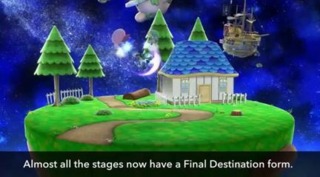
Most if not all stages feature an “Omega” variant. These variants feature an alternative flat, platform-less design meant to emulate the stage Final Destination, while offering a different theme and music selection. This option was created in response to the competitive community’s tendency to favor Final Destination over other more complex stages in previous Smash Bros. games.
Players can switch back and forth between the standard and Omega version of a stage from the stage select menu.
Trophies
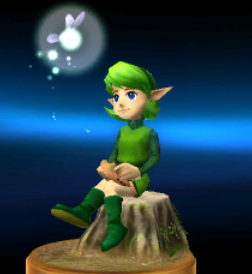
As in previous games in the Super Smash Bros. series, the player can unlock and collect a variety of trophies that represent characters, items, and locations taken from throughout Nintendo’s deep library of video games. The Wii U version has a total of 714 trophies (730 including DLC) and the 3DS version has 685 trophies (707 incuding DLC). This is much higher than Super Smash Bros. Brawl’s 544 trophy count. It is also possible to purchase trophies from a shop using Play Coins in the 3DS version.
Accessories
Amiibo Support
The Wii U version of Super Smash Bros. was one of the first Nintendo titles to support Amiibo; a line of NFC figurines that can send and receive data to and from the game through a chip in the Wii U GamePad. In the case of this game, the player can store custom data for a particular character in the respective figurine and then later spawn CPU controlled characters to fight either alongside a player-controlled character, or against other CPU, player-controlled, or Amiibo-generated characters. Players can also train their Amiibo through continued use of the character to level up their Amiibo to unlock new abilities and increase its stats.
The Nintendo 3DS version will also support Amiibo figurines in 2015 when the New Nintendo 3DS launches in the west and an NFC adapter is released for the original Nintendo 3DS and 2DS models.
GameCube Controller Support
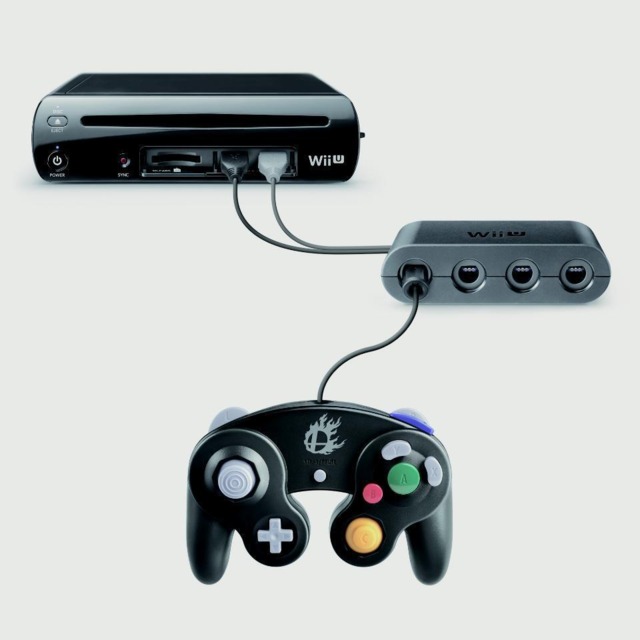
The Wii U version will be playable with GameCube controllers via a special adapter that plugs into the Wii U’s front USB-ports. Up to four wired GameCube controllers can plug into the adapter. It is also supports the use of wireless Wavebird GameCube controllers. The Wii U version will be sold in an optional bundle containing the game, the adapter and a Super Smash Bros.-branded controller. In Japan, a white Smash-branded GCN controller is also available. For 8-player Smash, two GameCube Controller adapters can be used at the same time.
Additionally, officially licensed GameCube controllers from third party manufacturer PDP will be available around the game’s launch. They come in various Nintendo character-themed colors such as Mario, Peach and Yoshi. Unlike standard GameCube controllers, the PDP controllers connect to a Wii Remote like a Wii Nunchuk or Classic Controller. PDP’s controllers also use analogue sticks based on those found in the Wii U GamePad instead of the regular GCN analog stick and the yellow C-Stick. The +Control Pad is based on the Wii U GamePad equivalent.
New Nintendo 3DS Enhancement
Super Smash Bros. for Nintendo 3DS is enhanced when played on a New Nintendo 3DS system by supporting the built-in C-Stick. While Circle Pad Pro compatible Nintendo 3DS software is also compatible with the C-Stick built into the New Nintendo 3DS, Super Smash Bros. for Nintendo 3DS is not compatible with the Circle Pad Pro accessory. It is also the case that the Circle Pad Pro requires the use of the 3DS IR sensor to function, and the Amiibo scanner peripheral also requires the use of the IR sensor.
Additionally, playing on a New Nintendo 3DS allows access to Miiverse and the internet browser, which is disabled when playing on original Nintendo 3DS models due to the game using up all available system memory. The New Nintendo 3DS system has more memory available and thus do not have this restriction.
Development
The game was announced during Nintendo’s E3 2011 press conference, but development had not yet started at that time. During a Nintendo Direct presentation on June 21, 2012, it was announced that in order to get the game done more quickly, Nintendo is partnering with Namco Bandai Games and Namco Bandai Studio with oversight by series creator Masahiro Sakurai at Sora. Development officially began after the completion of Sakurai’s previous game, Kid Icarus: Uprising.
The team at Namco Bandai working on the new Smash Bros. includes Masaya Kobayashi, Yoshito Higuchi (producer and director of the Tales… series), Tetsuya Akatsuka (producer and director of Mobile Suit Gundam: Extreme Vs.) and the art/sound director of the Soul Calibur series as well as the main development staff from the Tekken series.
The first footage of the game was revealed during a Nintendo Direct video stream on June 11, 2013. The video revealed a select few playable characters and also demonstrated that the game will use two different art styles; cel-shading on the 3DS, and a more standard shading on the Wii U.
On the June 11, 2013 E3 Nintendo Direct, the first three additions to the roster were revealed: the Villager from Animal Crossing, the female trainer from Wii Fit, and Mega Man. Following the game’s unveiling, a special Miiverse Director’s Room community for the game was established, and Sakurai regularly posted screenshots, unveiled characters, stages, techniques, or simply images he found amusing as a way to keep fans informed on the game’s progress. Though characters or features were frequently announced outside of the Super Smash Bros. website, they were typically added to the site within minutes of their unveiling.
Roster Leak
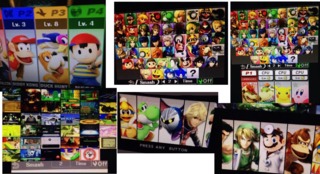
Over the weekend of August 23, 2014, screenshots surfaced purporting to display the full character selection roster of the 3DS version. This was followed by a collection of videos uploaded to YouTube that spread across the internet on August 25th. The videos featured various game footage and a user identification of ESRB0083 that suggested the video footage was meant for submission to the ESRB for rating evaluation purposes. Both the screenshots and video featured characters that had not yet been announced or confirmed as members of the game’s roster. It was eventually confirmed that the leaked images and video were real.
The videos were pulled down from YouTube at Nintendo’s request on August 25th. It has been rumored, but not confirmed, that the person behind the leak was an employee of Nintendo of America responsible for sending rating evaluation material to the ESRB. This individual has since been fired, and Nintendo intends to file a lawsuit against the ex-employee for violation of the company’s nondisclosure agreements.
3DS Demo
A demo for Super Smash Bros. for Nintendo 3DS was released in North America and Europe on September 19, 2014. On September 12, Nintendo of America and Nintendo of Europe sent early demo codes to Platinum Club Nintendo members over e-mail. The demo is very limited in scope; players can play either single-player or local multiplayer two-minute Smash battles. The only available stage in the demo is Battlefield, and the only characters available to play as are Mario, Link, Pikachu, Villager, and Mega Man.
Reception
Super Smash Bros. for Nintendo 3DS
Sales
In its Japanese opening weekend starting September 13, the game sold 1 million retail and download copies. In its Western launch weekend starting October 2, the game managed to sell about 1.4 million retail and download copies, bringing the total global numbers to 2.8 million copies sold. As of September 30, 2016, the 3DS version has sold 8.35 million copies worldwide.
Critical Reception
The 3DS version received generally positive reviews with many praising the fluid 60fps gameplay and full Smash experience being faithfully recreated on a handheld. Points of criticism were the small screen size during hectic battles, unfamiliar control ergonomics due to the platform’s nature and occasional lag during online matches. The 3DS exclusive Smash Run mode was criticized for not supporting online players and taking too long at five minutes for preparation with randomized match rules.
Super Smash Bros. for Wii U
The Wii U version has received very positive feedback and has even gained a strong presence in competitive tournament circles. However, some criticism was levied at the lack of an engrossing single-player/adventure mode similar to previous entries. This version of the game has sold 4.99 million copies worldwide as of September 30, 2016.
Leave a Reply